Organisational Behaviour Report: Google, Power, Culture, Motivation
VerifiedAdded on 2022/12/30
|15
|4044
|1
Report
AI Summary
This report provides an in-depth analysis of organisational behaviour, using Google as a case study. It examines the impact of organisational culture, power dynamics, and politics on individual and team performance, referencing Handy's culture model and exploring different sources of power. The report delves into content and process theories of motivation, including Maslow's hierarchy of needs and Adam's equity theory, to understand how these theories can be applied to achieve organisational goals. Furthermore, it compares and contrasts the characteristics of effective and ineffective teams, highlighting the importance of clear communication, goal setting, accountability, and collaboration. The report concludes by outlining the concepts and philosophies of organisational behaviour, offering valuable insights into how these principles can be applied in a real-world organisational setting.
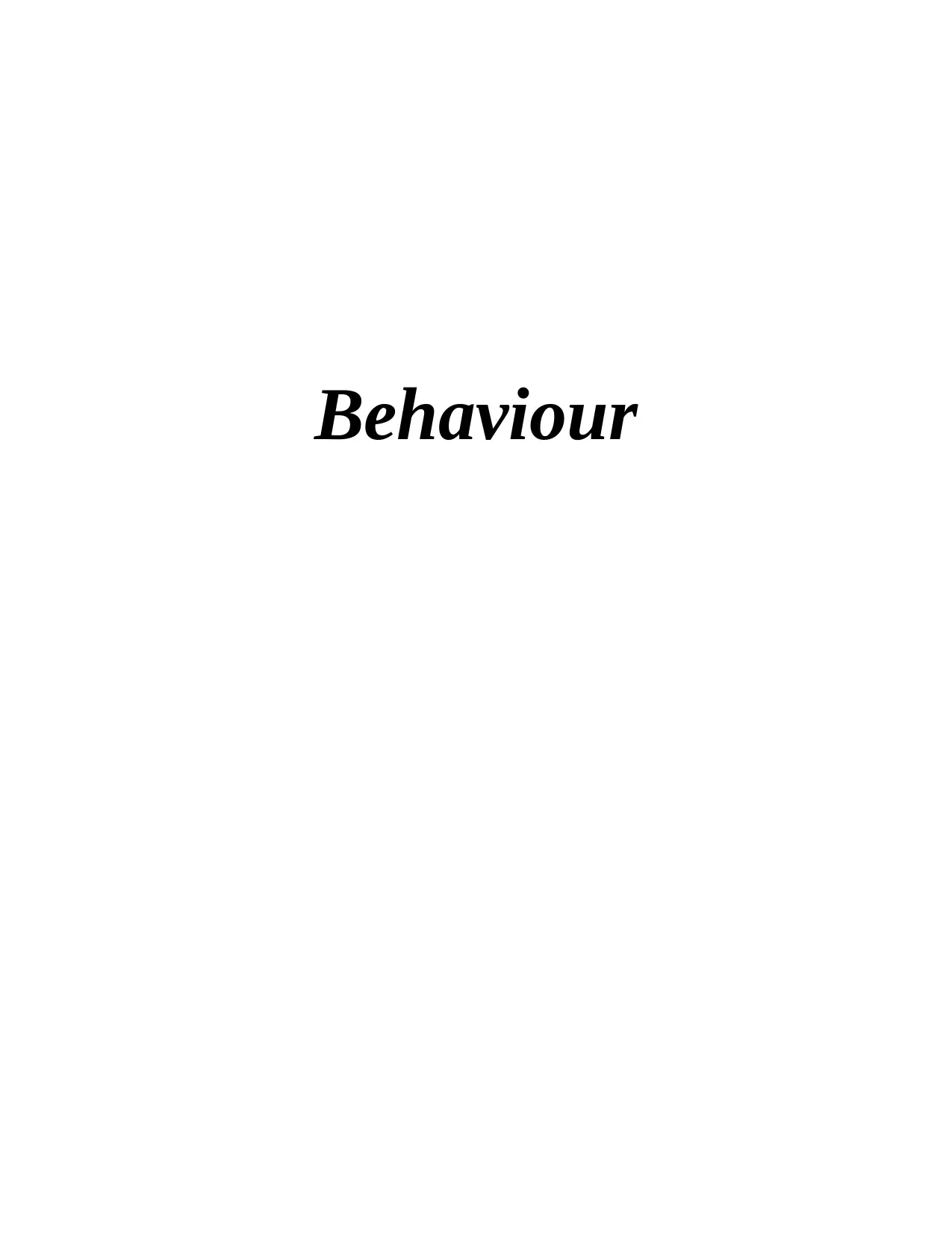
Behaviour
Paraphrase This Document
Need a fresh take? Get an instant paraphrase of this document with our AI Paraphraser
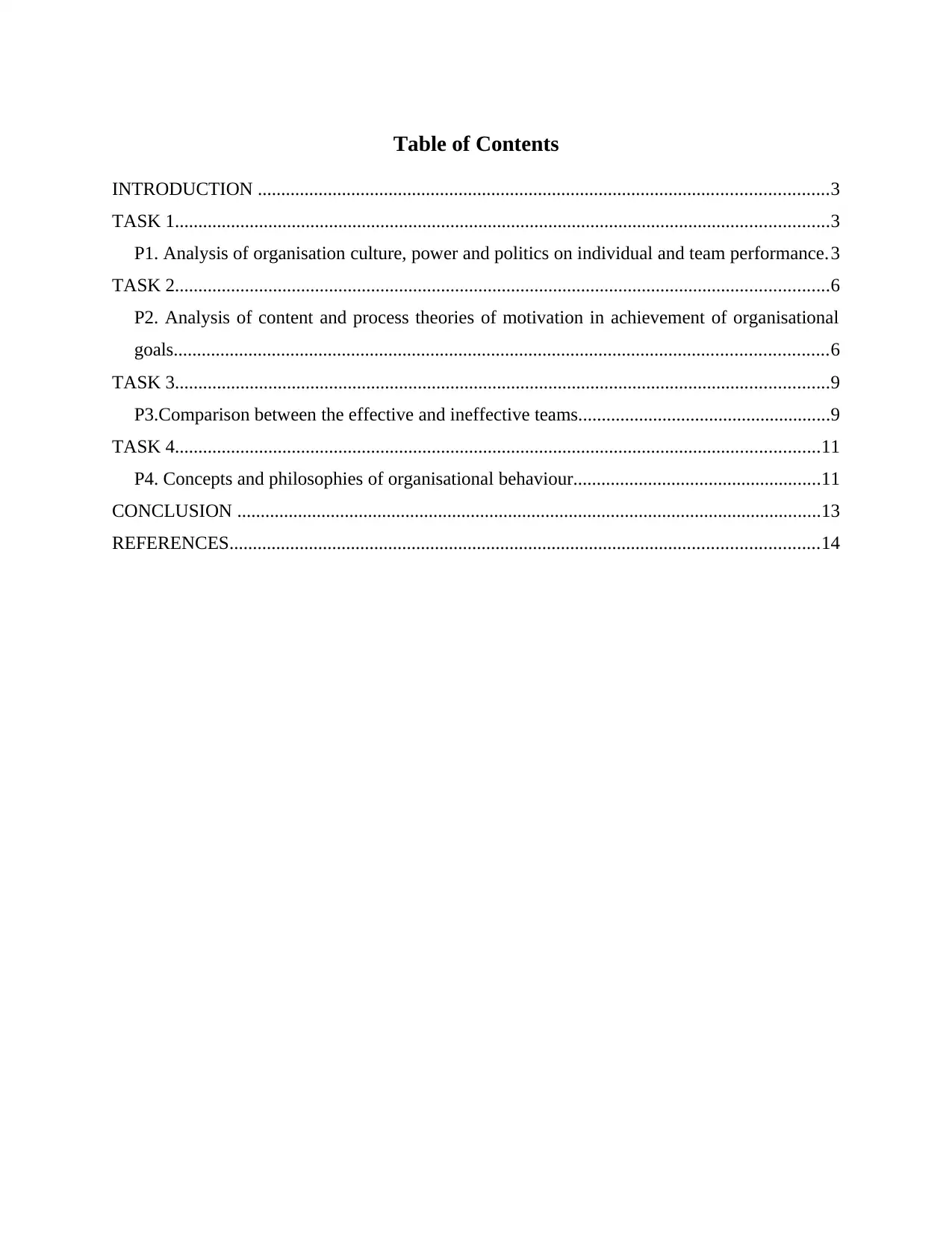
Table of Contents
INTRODUCTION ..........................................................................................................................3
TASK 1............................................................................................................................................3
P1. Analysis of organisation culture, power and politics on individual and team performance.3
TASK 2............................................................................................................................................6
P2. Analysis of content and process theories of motivation in achievement of organisational
goals............................................................................................................................................6
TASK 3............................................................................................................................................9
P3.Comparison between the effective and ineffective teams......................................................9
TASK 4..........................................................................................................................................11
P4. Concepts and philosophies of organisational behaviour.....................................................11
CONCLUSION .............................................................................................................................13
REFERENCES..............................................................................................................................14
INTRODUCTION ..........................................................................................................................3
TASK 1............................................................................................................................................3
P1. Analysis of organisation culture, power and politics on individual and team performance.3
TASK 2............................................................................................................................................6
P2. Analysis of content and process theories of motivation in achievement of organisational
goals............................................................................................................................................6
TASK 3............................................................................................................................................9
P3.Comparison between the effective and ineffective teams......................................................9
TASK 4..........................................................................................................................................11
P4. Concepts and philosophies of organisational behaviour.....................................................11
CONCLUSION .............................................................................................................................13
REFERENCES..............................................................................................................................14
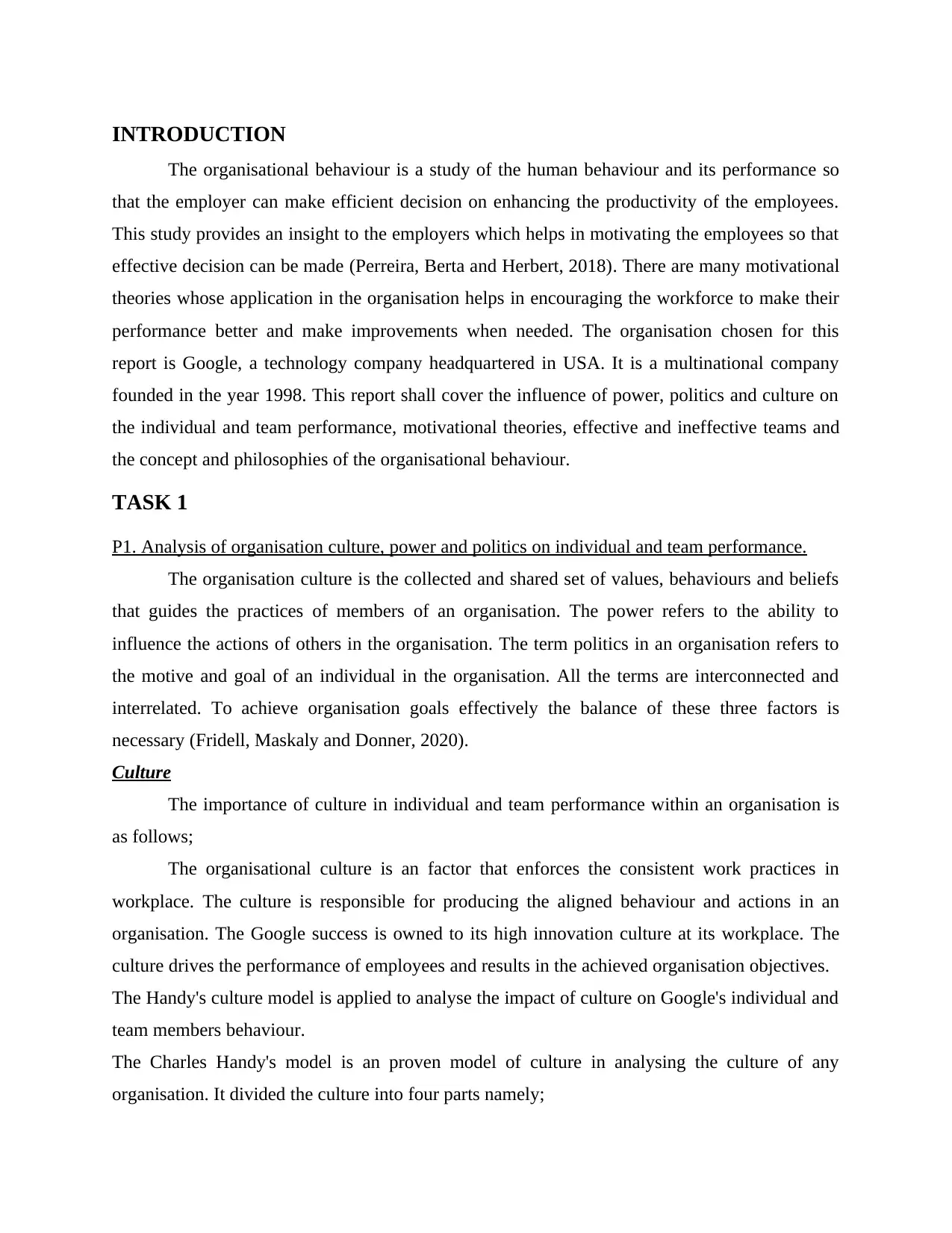
INTRODUCTION
The organisational behaviour is a study of the human behaviour and its performance so
that the employer can make efficient decision on enhancing the productivity of the employees.
This study provides an insight to the employers which helps in motivating the employees so that
effective decision can be made (Perreira, Berta and Herbert, 2018). There are many motivational
theories whose application in the organisation helps in encouraging the workforce to make their
performance better and make improvements when needed. The organisation chosen for this
report is Google, a technology company headquartered in USA. It is a multinational company
founded in the year 1998. This report shall cover the influence of power, politics and culture on
the individual and team performance, motivational theories, effective and ineffective teams and
the concept and philosophies of the organisational behaviour.
TASK 1
P1. Analysis of organisation culture, power and politics on individual and team performance.
The organisation culture is the collected and shared set of values, behaviours and beliefs
that guides the practices of members of an organisation. The power refers to the ability to
influence the actions of others in the organisation. The term politics in an organisation refers to
the motive and goal of an individual in the organisation. All the terms are interconnected and
interrelated. To achieve organisation goals effectively the balance of these three factors is
necessary (Fridell, Maskaly and Donner, 2020).
Culture
The importance of culture in individual and team performance within an organisation is
as follows;
The organisational culture is an factor that enforces the consistent work practices in
workplace. The culture is responsible for producing the aligned behaviour and actions in an
organisation. The Google success is owned to its high innovation culture at its workplace. The
culture drives the performance of employees and results in the achieved organisation objectives.
The Handy's culture model is applied to analyse the impact of culture on Google's individual and
team members behaviour.
The Charles Handy's model is an proven model of culture in analysing the culture of any
organisation. It divided the culture into four parts namely;
The organisational behaviour is a study of the human behaviour and its performance so
that the employer can make efficient decision on enhancing the productivity of the employees.
This study provides an insight to the employers which helps in motivating the employees so that
effective decision can be made (Perreira, Berta and Herbert, 2018). There are many motivational
theories whose application in the organisation helps in encouraging the workforce to make their
performance better and make improvements when needed. The organisation chosen for this
report is Google, a technology company headquartered in USA. It is a multinational company
founded in the year 1998. This report shall cover the influence of power, politics and culture on
the individual and team performance, motivational theories, effective and ineffective teams and
the concept and philosophies of the organisational behaviour.
TASK 1
P1. Analysis of organisation culture, power and politics on individual and team performance.
The organisation culture is the collected and shared set of values, behaviours and beliefs
that guides the practices of members of an organisation. The power refers to the ability to
influence the actions of others in the organisation. The term politics in an organisation refers to
the motive and goal of an individual in the organisation. All the terms are interconnected and
interrelated. To achieve organisation goals effectively the balance of these three factors is
necessary (Fridell, Maskaly and Donner, 2020).
Culture
The importance of culture in individual and team performance within an organisation is
as follows;
The organisational culture is an factor that enforces the consistent work practices in
workplace. The culture is responsible for producing the aligned behaviour and actions in an
organisation. The Google success is owned to its high innovation culture at its workplace. The
culture drives the performance of employees and results in the achieved organisation objectives.
The Handy's culture model is applied to analyse the impact of culture on Google's individual and
team members behaviour.
The Charles Handy's model is an proven model of culture in analysing the culture of any
organisation. It divided the culture into four parts namely;
⊘ This is a preview!⊘
Do you want full access?
Subscribe today to unlock all pages.

Trusted by 1+ million students worldwide
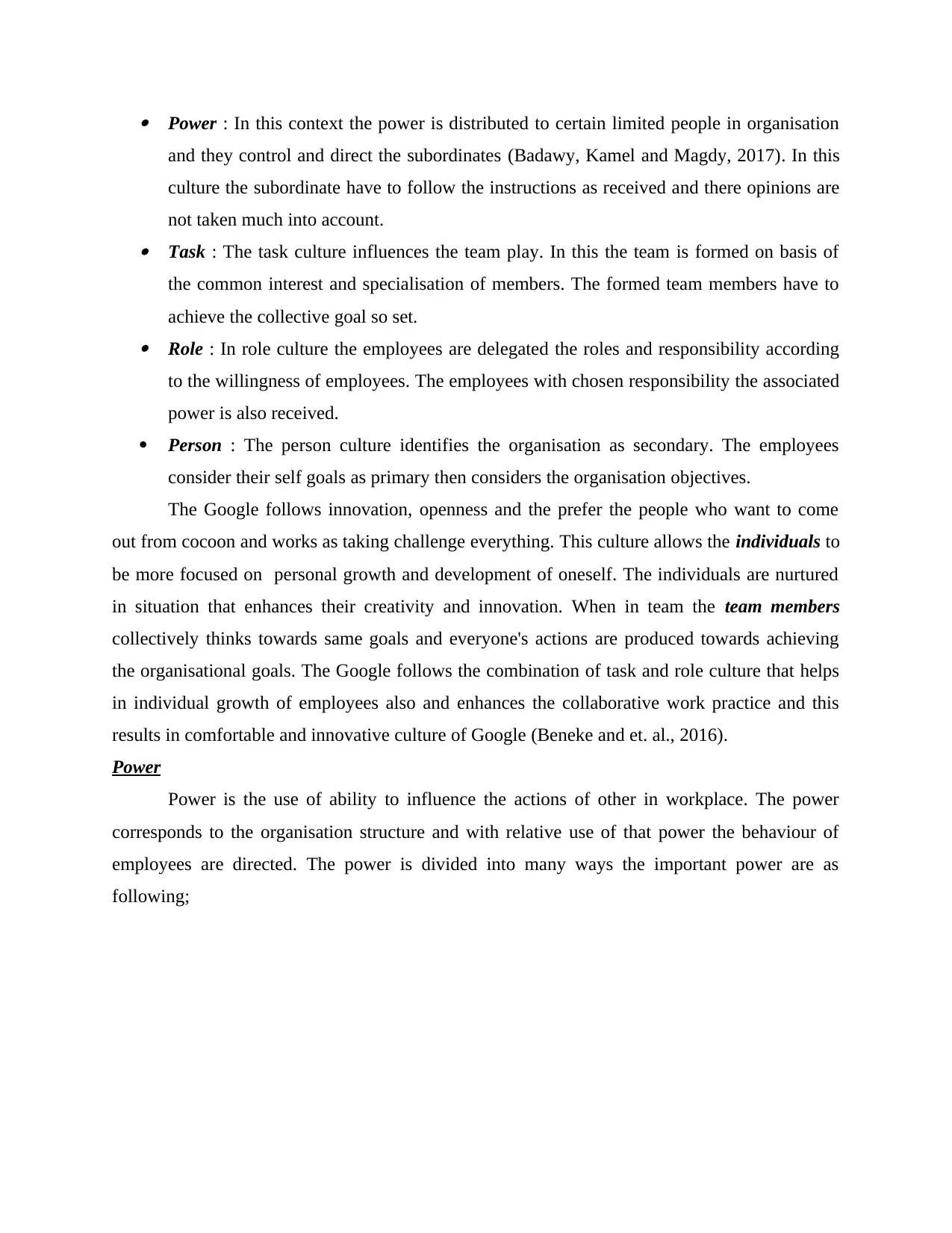
Power : In this context the power is distributed to certain limited people in organisation
and they control and direct the subordinates (Badawy, Kamel and Magdy, 2017). In this
culture the subordinate have to follow the instructions as received and there opinions are
not taken much into account. Task : The task culture influences the team play. In this the team is formed on basis of
the common interest and specialisation of members. The formed team members have to
achieve the collective goal so set. Role : In role culture the employees are delegated the roles and responsibility according
to the willingness of employees. The employees with chosen responsibility the associated
power is also received.
Person : The person culture identifies the organisation as secondary. The employees
consider their self goals as primary then considers the organisation objectives.
The Google follows innovation, openness and the prefer the people who want to come
out from cocoon and works as taking challenge everything. This culture allows the individuals to
be more focused on personal growth and development of oneself. The individuals are nurtured
in situation that enhances their creativity and innovation. When in team the team members
collectively thinks towards same goals and everyone's actions are produced towards achieving
the organisational goals. The Google follows the combination of task and role culture that helps
in individual growth of employees also and enhances the collaborative work practice and this
results in comfortable and innovative culture of Google (Beneke and et. al., 2016).
Power
Power is the use of ability to influence the actions of other in workplace. The power
corresponds to the organisation structure and with relative use of that power the behaviour of
employees are directed. The power is divided into many ways the important power are as
following;
and they control and direct the subordinates (Badawy, Kamel and Magdy, 2017). In this
culture the subordinate have to follow the instructions as received and there opinions are
not taken much into account. Task : The task culture influences the team play. In this the team is formed on basis of
the common interest and specialisation of members. The formed team members have to
achieve the collective goal so set. Role : In role culture the employees are delegated the roles and responsibility according
to the willingness of employees. The employees with chosen responsibility the associated
power is also received.
Person : The person culture identifies the organisation as secondary. The employees
consider their self goals as primary then considers the organisation objectives.
The Google follows innovation, openness and the prefer the people who want to come
out from cocoon and works as taking challenge everything. This culture allows the individuals to
be more focused on personal growth and development of oneself. The individuals are nurtured
in situation that enhances their creativity and innovation. When in team the team members
collectively thinks towards same goals and everyone's actions are produced towards achieving
the organisational goals. The Google follows the combination of task and role culture that helps
in individual growth of employees also and enhances the collaborative work practice and this
results in comfortable and innovative culture of Google (Beneke and et. al., 2016).
Power
Power is the use of ability to influence the actions of other in workplace. The power
corresponds to the organisation structure and with relative use of that power the behaviour of
employees are directed. The power is divided into many ways the important power are as
following;
Paraphrase This Document
Need a fresh take? Get an instant paraphrase of this document with our AI Paraphraser
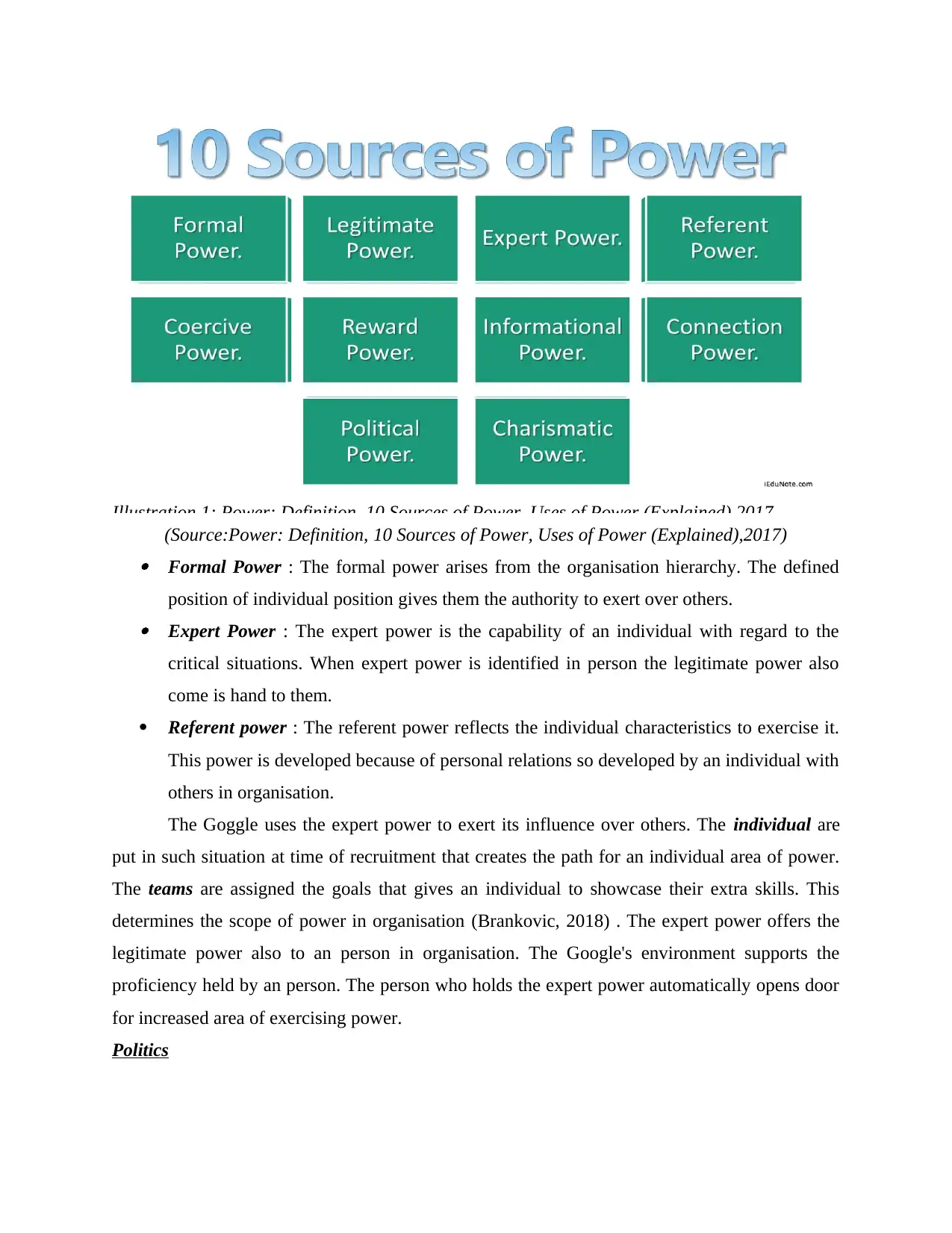
Illustration 1: Power: Definition, 10 Sources of Power, Uses of Power (Explained),2017
(Source:Power: Definition, 10 Sources of Power, Uses of Power (Explained),2017) Formal Power : The formal power arises from the organisation hierarchy. The defined
position of individual position gives them the authority to exert over others. Expert Power : The expert power is the capability of an individual with regard to the
critical situations. When expert power is identified in person the legitimate power also
come is hand to them.
Referent power : The referent power reflects the individual characteristics to exercise it.
This power is developed because of personal relations so developed by an individual with
others in organisation.
The Goggle uses the expert power to exert its influence over others. The individual are
put in such situation at time of recruitment that creates the path for an individual area of power.
The teams are assigned the goals that gives an individual to showcase their extra skills. This
determines the scope of power in organisation (Brankovic, 2018) . The expert power offers the
legitimate power also to an person in organisation. The Google's environment supports the
proficiency held by an person. The person who holds the expert power automatically opens door
for increased area of exercising power.
Politics
(Source:Power: Definition, 10 Sources of Power, Uses of Power (Explained),2017) Formal Power : The formal power arises from the organisation hierarchy. The defined
position of individual position gives them the authority to exert over others. Expert Power : The expert power is the capability of an individual with regard to the
critical situations. When expert power is identified in person the legitimate power also
come is hand to them.
Referent power : The referent power reflects the individual characteristics to exercise it.
This power is developed because of personal relations so developed by an individual with
others in organisation.
The Goggle uses the expert power to exert its influence over others. The individual are
put in such situation at time of recruitment that creates the path for an individual area of power.
The teams are assigned the goals that gives an individual to showcase their extra skills. This
determines the scope of power in organisation (Brankovic, 2018) . The expert power offers the
legitimate power also to an person in organisation. The Google's environment supports the
proficiency held by an person. The person who holds the expert power automatically opens door
for increased area of exercising power.
Politics
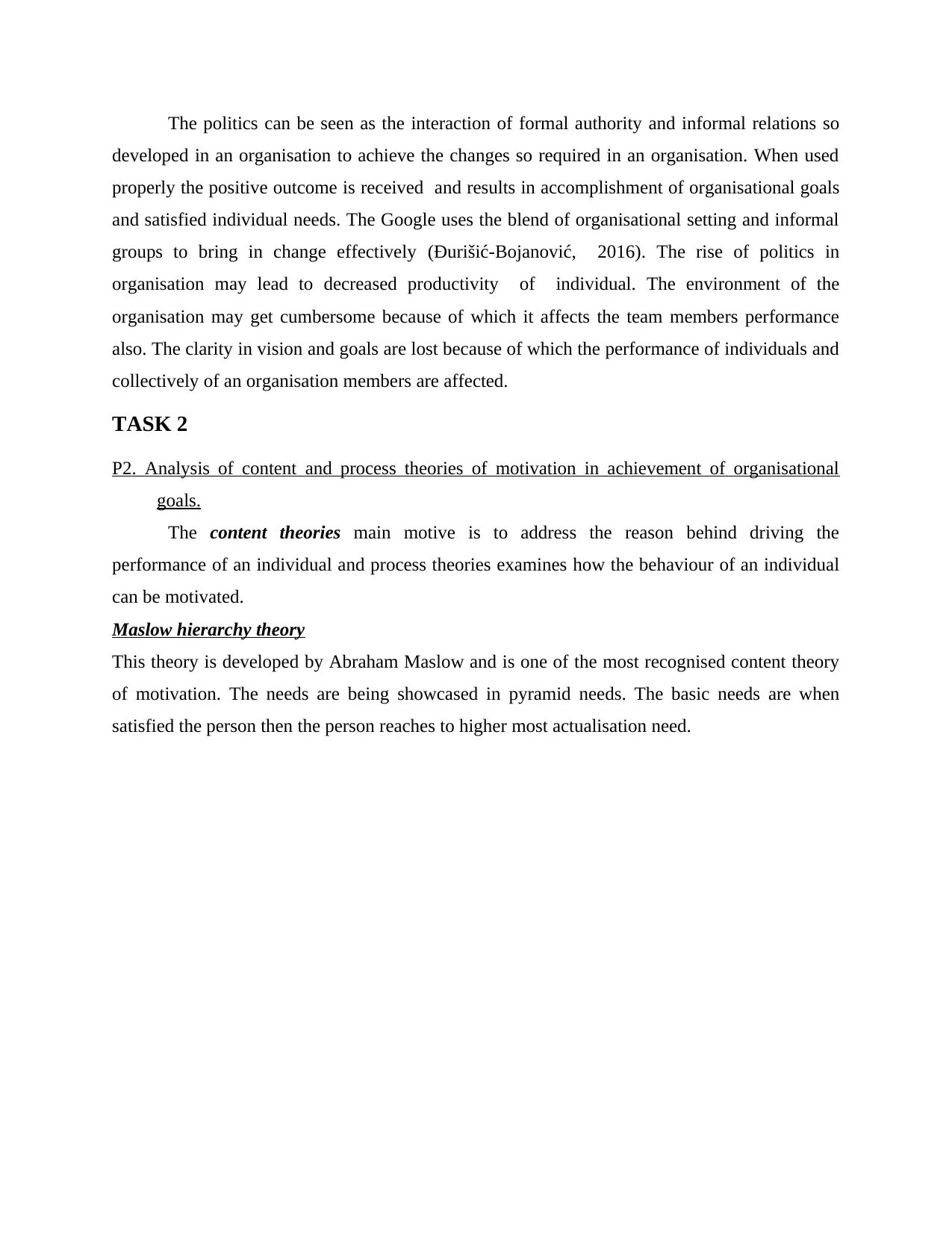
The politics can be seen as the interaction of formal authority and informal relations so
developed in an organisation to achieve the changes so required in an organisation. When used
properly the positive outcome is received and results in accomplishment of organisational goals
and satisfied individual needs. The Google uses the blend of organisational setting and informal
groups to bring in change effectively (Đurišić-Bojanović, 2016). The rise of politics in
organisation may lead to decreased productivity of individual. The environment of the
organisation may get cumbersome because of which it affects the team members performance
also. The clarity in vision and goals are lost because of which the performance of individuals and
collectively of an organisation members are affected.
TASK 2
P2. Analysis of content and process theories of motivation in achievement of organisational
goals.
The content theories main motive is to address the reason behind driving the
performance of an individual and process theories examines how the behaviour of an individual
can be motivated.
Maslow hierarchy theory
This theory is developed by Abraham Maslow and is one of the most recognised content theory
of motivation. The needs are being showcased in pyramid needs. The basic needs are when
satisfied the person then the person reaches to higher most actualisation need.
developed in an organisation to achieve the changes so required in an organisation. When used
properly the positive outcome is received and results in accomplishment of organisational goals
and satisfied individual needs. The Google uses the blend of organisational setting and informal
groups to bring in change effectively (Đurišić-Bojanović, 2016). The rise of politics in
organisation may lead to decreased productivity of individual. The environment of the
organisation may get cumbersome because of which it affects the team members performance
also. The clarity in vision and goals are lost because of which the performance of individuals and
collectively of an organisation members are affected.
TASK 2
P2. Analysis of content and process theories of motivation in achievement of organisational
goals.
The content theories main motive is to address the reason behind driving the
performance of an individual and process theories examines how the behaviour of an individual
can be motivated.
Maslow hierarchy theory
This theory is developed by Abraham Maslow and is one of the most recognised content theory
of motivation. The needs are being showcased in pyramid needs. The basic needs are when
satisfied the person then the person reaches to higher most actualisation need.
⊘ This is a preview!⊘
Do you want full access?
Subscribe today to unlock all pages.

Trusted by 1+ million students worldwide
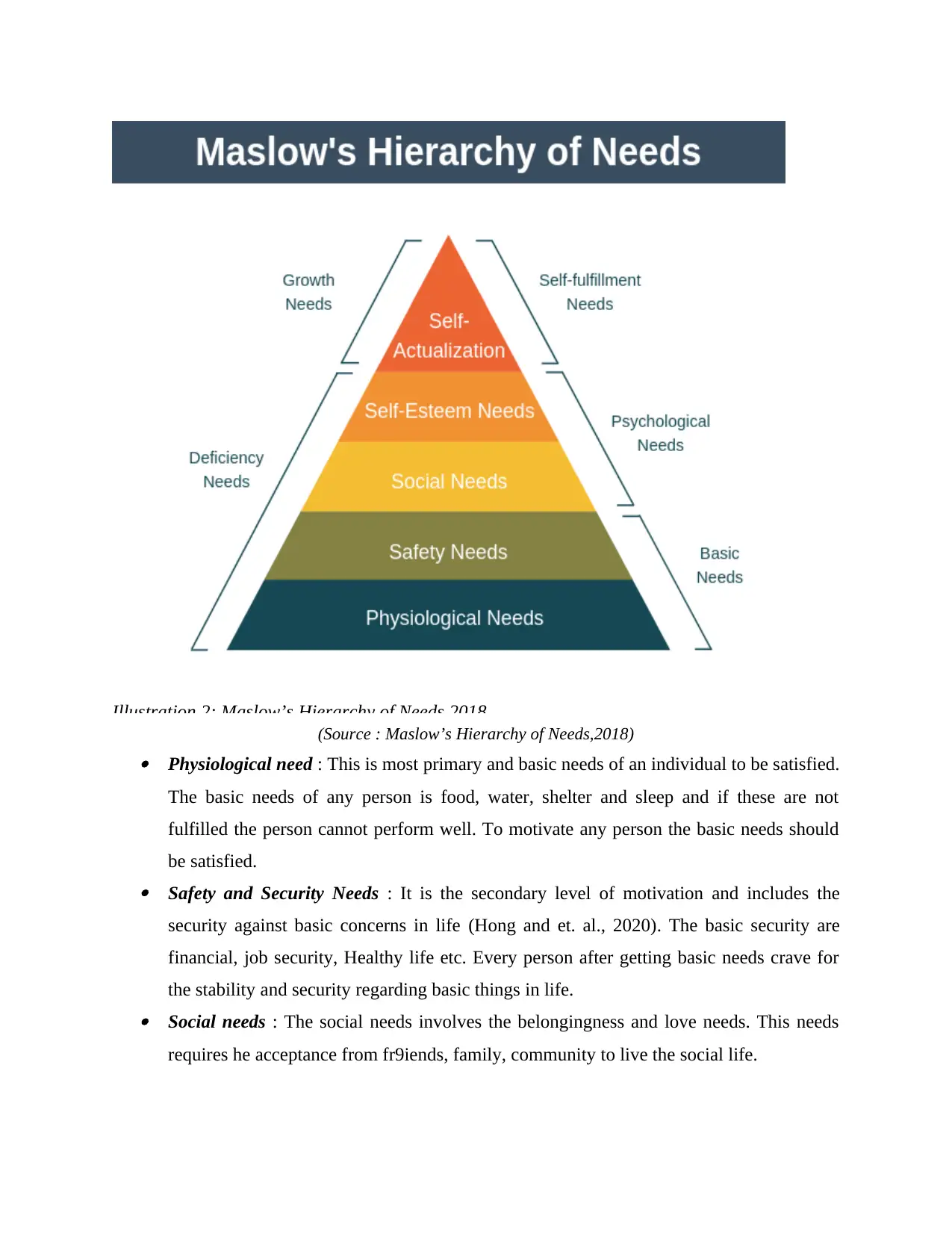
Illustration 2: Maslow’s Hierarchy of Needs,2018
(Source : Maslow’s Hierarchy of Needs,2018) Physiological need : This is most primary and basic needs of an individual to be satisfied.
The basic needs of any person is food, water, shelter and sleep and if these are not
fulfilled the person cannot perform well. To motivate any person the basic needs should
be satisfied. Safety and Security Needs : It is the secondary level of motivation and includes the
security against basic concerns in life (Hong and et. al., 2020). The basic security are
financial, job security, Healthy life etc. Every person after getting basic needs crave for
the stability and security regarding basic things in life. Social needs : The social needs involves the belongingness and love needs. This needs
requires he acceptance from fr9iends, family, community to live the social life.
(Source : Maslow’s Hierarchy of Needs,2018) Physiological need : This is most primary and basic needs of an individual to be satisfied.
The basic needs of any person is food, water, shelter and sleep and if these are not
fulfilled the person cannot perform well. To motivate any person the basic needs should
be satisfied. Safety and Security Needs : It is the secondary level of motivation and includes the
security against basic concerns in life (Hong and et. al., 2020). The basic security are
financial, job security, Healthy life etc. Every person after getting basic needs crave for
the stability and security regarding basic things in life. Social needs : The social needs involves the belongingness and love needs. This needs
requires he acceptance from fr9iends, family, community to live the social life.
Paraphrase This Document
Need a fresh take? Get an instant paraphrase of this document with our AI Paraphraser
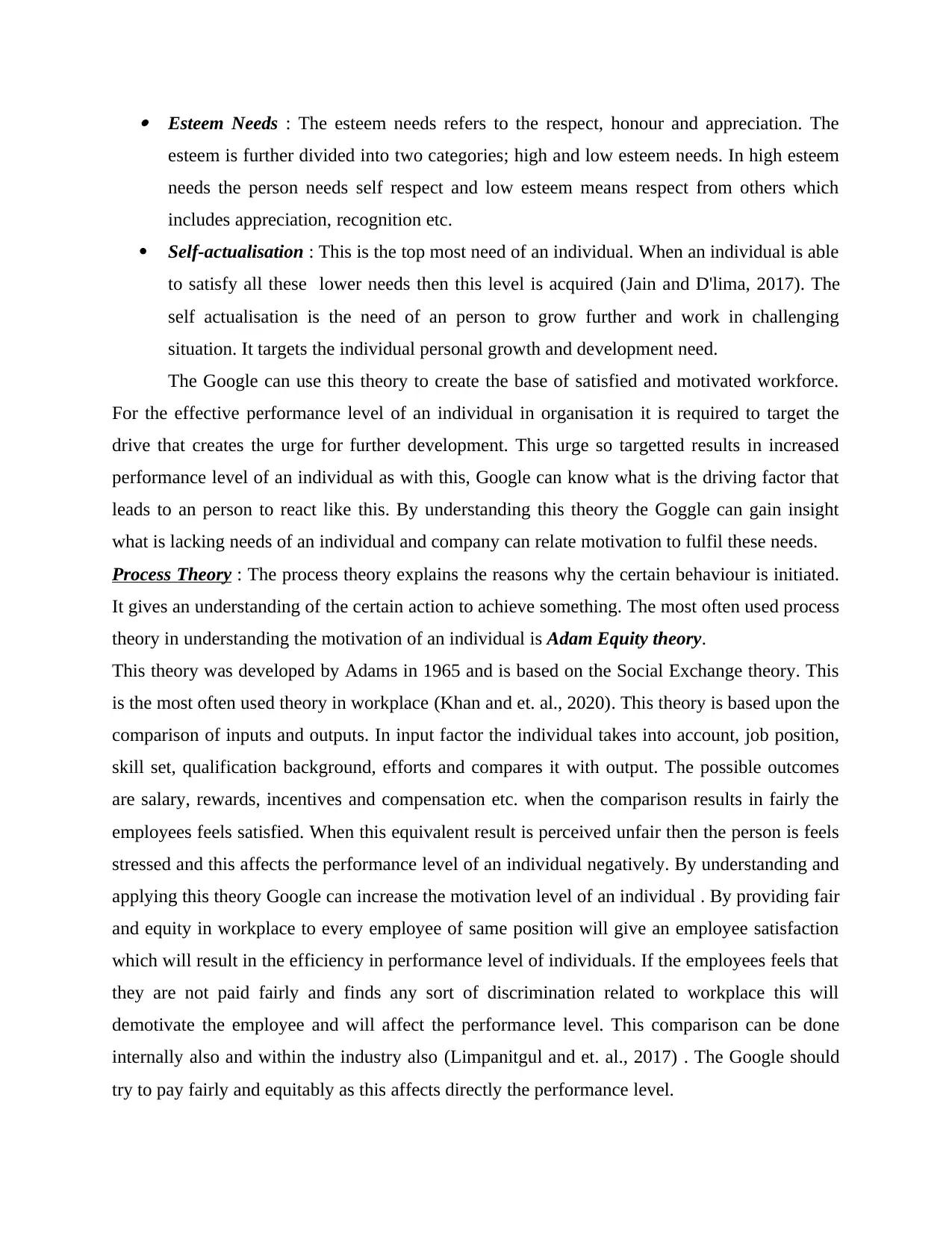
Esteem Needs : The esteem needs refers to the respect, honour and appreciation. The
esteem is further divided into two categories; high and low esteem needs. In high esteem
needs the person needs self respect and low esteem means respect from others which
includes appreciation, recognition etc.
Self-actualisation : This is the top most need of an individual. When an individual is able
to satisfy all these lower needs then this level is acquired (Jain and D'lima, 2017). The
self actualisation is the need of an person to grow further and work in challenging
situation. It targets the individual personal growth and development need.
The Google can use this theory to create the base of satisfied and motivated workforce.
For the effective performance level of an individual in organisation it is required to target the
drive that creates the urge for further development. This urge so targetted results in increased
performance level of an individual as with this, Google can know what is the driving factor that
leads to an person to react like this. By understanding this theory the Goggle can gain insight
what is lacking needs of an individual and company can relate motivation to fulfil these needs.
Process Theory : The process theory explains the reasons why the certain behaviour is initiated.
It gives an understanding of the certain action to achieve something. The most often used process
theory in understanding the motivation of an individual is Adam Equity theory.
This theory was developed by Adams in 1965 and is based on the Social Exchange theory. This
is the most often used theory in workplace (Khan and et. al., 2020). This theory is based upon the
comparison of inputs and outputs. In input factor the individual takes into account, job position,
skill set, qualification background, efforts and compares it with output. The possible outcomes
are salary, rewards, incentives and compensation etc. when the comparison results in fairly the
employees feels satisfied. When this equivalent result is perceived unfair then the person is feels
stressed and this affects the performance level of an individual negatively. By understanding and
applying this theory Google can increase the motivation level of an individual . By providing fair
and equity in workplace to every employee of same position will give an employee satisfaction
which will result in the efficiency in performance level of individuals. If the employees feels that
they are not paid fairly and finds any sort of discrimination related to workplace this will
demotivate the employee and will affect the performance level. This comparison can be done
internally also and within the industry also (Limpanitgul and et. al., 2017) . The Google should
try to pay fairly and equitably as this affects directly the performance level.
esteem is further divided into two categories; high and low esteem needs. In high esteem
needs the person needs self respect and low esteem means respect from others which
includes appreciation, recognition etc.
Self-actualisation : This is the top most need of an individual. When an individual is able
to satisfy all these lower needs then this level is acquired (Jain and D'lima, 2017). The
self actualisation is the need of an person to grow further and work in challenging
situation. It targets the individual personal growth and development need.
The Google can use this theory to create the base of satisfied and motivated workforce.
For the effective performance level of an individual in organisation it is required to target the
drive that creates the urge for further development. This urge so targetted results in increased
performance level of an individual as with this, Google can know what is the driving factor that
leads to an person to react like this. By understanding this theory the Goggle can gain insight
what is lacking needs of an individual and company can relate motivation to fulfil these needs.
Process Theory : The process theory explains the reasons why the certain behaviour is initiated.
It gives an understanding of the certain action to achieve something. The most often used process
theory in understanding the motivation of an individual is Adam Equity theory.
This theory was developed by Adams in 1965 and is based on the Social Exchange theory. This
is the most often used theory in workplace (Khan and et. al., 2020). This theory is based upon the
comparison of inputs and outputs. In input factor the individual takes into account, job position,
skill set, qualification background, efforts and compares it with output. The possible outcomes
are salary, rewards, incentives and compensation etc. when the comparison results in fairly the
employees feels satisfied. When this equivalent result is perceived unfair then the person is feels
stressed and this affects the performance level of an individual negatively. By understanding and
applying this theory Google can increase the motivation level of an individual . By providing fair
and equity in workplace to every employee of same position will give an employee satisfaction
which will result in the efficiency in performance level of individuals. If the employees feels that
they are not paid fairly and finds any sort of discrimination related to workplace this will
demotivate the employee and will affect the performance level. This comparison can be done
internally also and within the industry also (Limpanitgul and et. al., 2017) . The Google should
try to pay fairly and equitably as this affects directly the performance level.
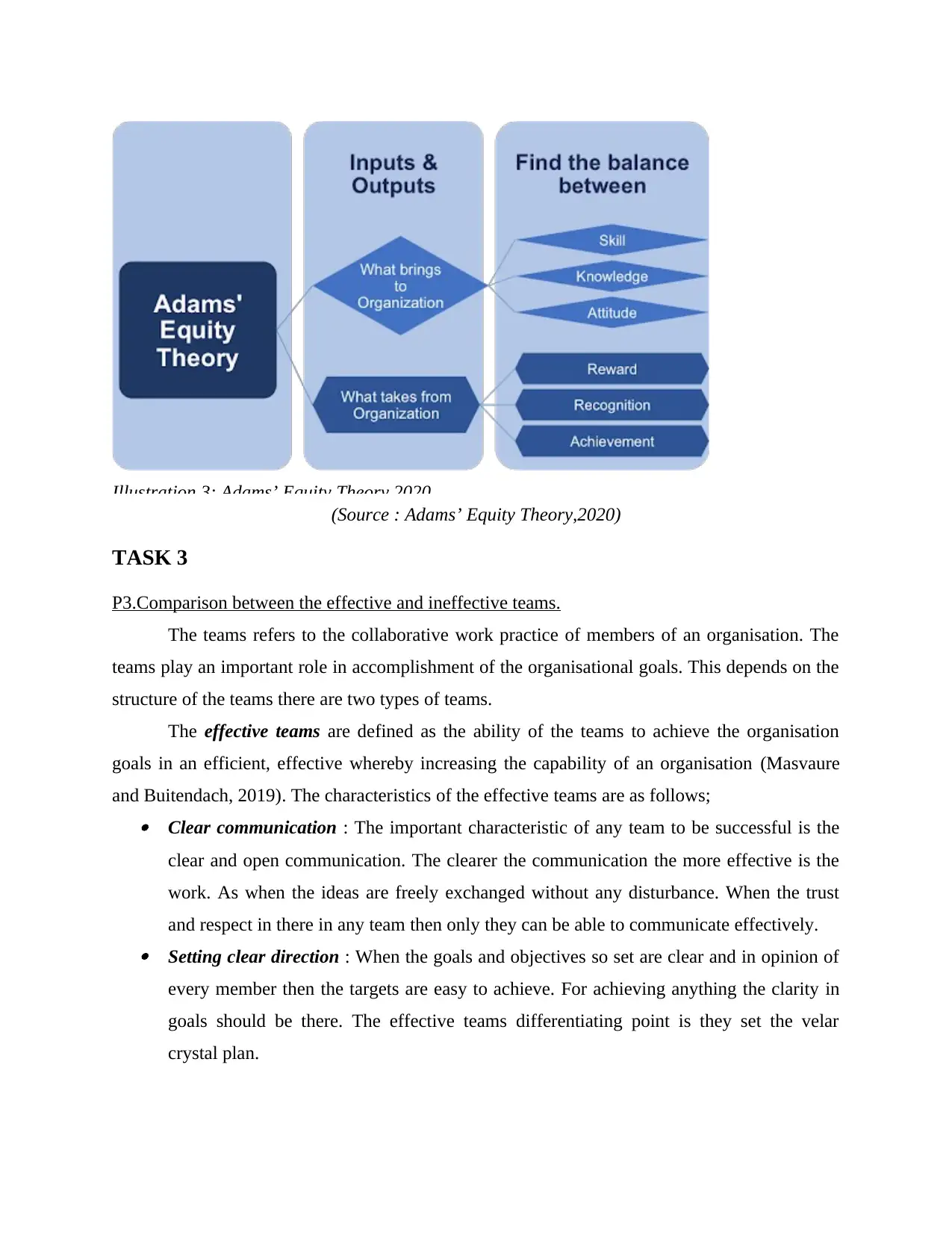
Illustration 3: Adams’ Equity Theory,2020
(Source : Adams’ Equity Theory,2020)
TASK 3
P3.Comparison between the effective and ineffective teams.
The teams refers to the collaborative work practice of members of an organisation. The
teams play an important role in accomplishment of the organisational goals. This depends on the
structure of the teams there are two types of teams.
The effective teams are defined as the ability of the teams to achieve the organisation
goals in an efficient, effective whereby increasing the capability of an organisation (Masvaure
and Buitendach, 2019). The characteristics of the effective teams are as follows; Clear communication : The important characteristic of any team to be successful is the
clear and open communication. The clearer the communication the more effective is the
work. As when the ideas are freely exchanged without any disturbance. When the trust
and respect in there in any team then only they can be able to communicate effectively. Setting clear direction : When the goals and objectives so set are clear and in opinion of
every member then the targets are easy to achieve. For achieving anything the clarity in
goals should be there. The effective teams differentiating point is they set the velar
crystal plan.
(Source : Adams’ Equity Theory,2020)
TASK 3
P3.Comparison between the effective and ineffective teams.
The teams refers to the collaborative work practice of members of an organisation. The
teams play an important role in accomplishment of the organisational goals. This depends on the
structure of the teams there are two types of teams.
The effective teams are defined as the ability of the teams to achieve the organisation
goals in an efficient, effective whereby increasing the capability of an organisation (Masvaure
and Buitendach, 2019). The characteristics of the effective teams are as follows; Clear communication : The important characteristic of any team to be successful is the
clear and open communication. The clearer the communication the more effective is the
work. As when the ideas are freely exchanged without any disturbance. When the trust
and respect in there in any team then only they can be able to communicate effectively. Setting clear direction : When the goals and objectives so set are clear and in opinion of
every member then the targets are easy to achieve. For achieving anything the clarity in
goals should be there. The effective teams differentiating point is they set the velar
crystal plan.
⊘ This is a preview!⊘
Do you want full access?
Subscribe today to unlock all pages.

Trusted by 1+ million students worldwide
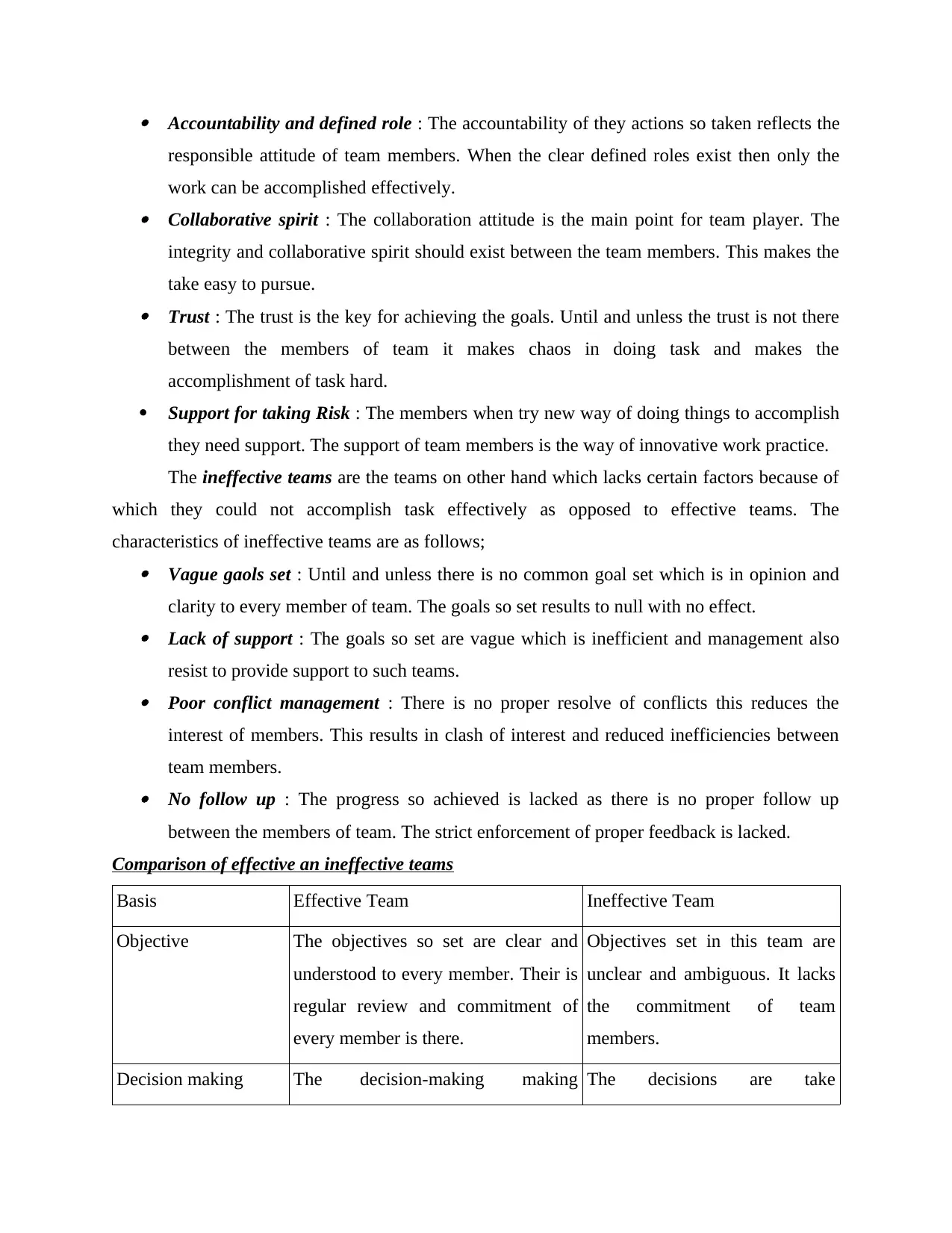
Accountability and defined role : The accountability of they actions so taken reflects the
responsible attitude of team members. When the clear defined roles exist then only the
work can be accomplished effectively. Collaborative spirit : The collaboration attitude is the main point for team player. The
integrity and collaborative spirit should exist between the team members. This makes the
take easy to pursue. Trust : The trust is the key for achieving the goals. Until and unless the trust is not there
between the members of team it makes chaos in doing task and makes the
accomplishment of task hard.
Support for taking Risk : The members when try new way of doing things to accomplish
they need support. The support of team members is the way of innovative work practice.
The ineffective teams are the teams on other hand which lacks certain factors because of
which they could not accomplish task effectively as opposed to effective teams. The
characteristics of ineffective teams are as follows; Vague gaols set : Until and unless there is no common goal set which is in opinion and
clarity to every member of team. The goals so set results to null with no effect. Lack of support : The goals so set are vague which is inefficient and management also
resist to provide support to such teams. Poor conflict management : There is no proper resolve of conflicts this reduces the
interest of members. This results in clash of interest and reduced inefficiencies between
team members. No follow up : The progress so achieved is lacked as there is no proper follow up
between the members of team. The strict enforcement of proper feedback is lacked.
Comparison of effective an ineffective teams
Basis Effective Team Ineffective Team
Objective The objectives so set are clear and
understood to every member. Their is
regular review and commitment of
every member is there.
Objectives set in this team are
unclear and ambiguous. It lacks
the commitment of team
members.
Decision making The decision-making making The decisions are take
responsible attitude of team members. When the clear defined roles exist then only the
work can be accomplished effectively. Collaborative spirit : The collaboration attitude is the main point for team player. The
integrity and collaborative spirit should exist between the team members. This makes the
take easy to pursue. Trust : The trust is the key for achieving the goals. Until and unless the trust is not there
between the members of team it makes chaos in doing task and makes the
accomplishment of task hard.
Support for taking Risk : The members when try new way of doing things to accomplish
they need support. The support of team members is the way of innovative work practice.
The ineffective teams are the teams on other hand which lacks certain factors because of
which they could not accomplish task effectively as opposed to effective teams. The
characteristics of ineffective teams are as follows; Vague gaols set : Until and unless there is no common goal set which is in opinion and
clarity to every member of team. The goals so set results to null with no effect. Lack of support : The goals so set are vague which is inefficient and management also
resist to provide support to such teams. Poor conflict management : There is no proper resolve of conflicts this reduces the
interest of members. This results in clash of interest and reduced inefficiencies between
team members. No follow up : The progress so achieved is lacked as there is no proper follow up
between the members of team. The strict enforcement of proper feedback is lacked.
Comparison of effective an ineffective teams
Basis Effective Team Ineffective Team
Objective The objectives so set are clear and
understood to every member. Their is
regular review and commitment of
every member is there.
Objectives set in this team are
unclear and ambiguous. It lacks
the commitment of team
members.
Decision making The decision-making making The decisions are take
Paraphrase This Document
Need a fresh take? Get an instant paraphrase of this document with our AI Paraphraser
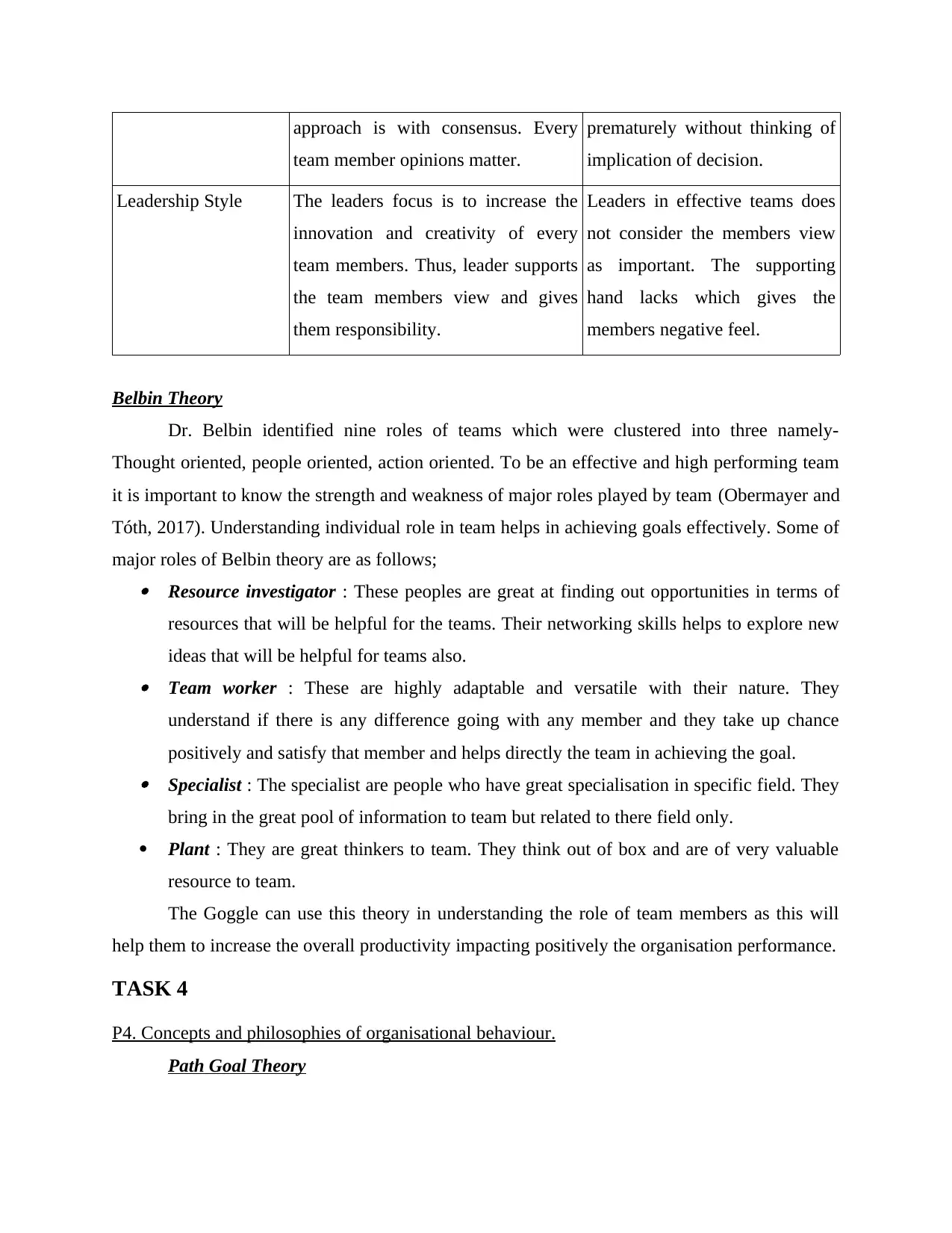
approach is with consensus. Every
team member opinions matter.
prematurely without thinking of
implication of decision.
Leadership Style The leaders focus is to increase the
innovation and creativity of every
team members. Thus, leader supports
the team members view and gives
them responsibility.
Leaders in effective teams does
not consider the members view
as important. The supporting
hand lacks which gives the
members negative feel.
Belbin Theory
Dr. Belbin identified nine roles of teams which were clustered into three namely-
Thought oriented, people oriented, action oriented. To be an effective and high performing team
it is important to know the strength and weakness of major roles played by team (Obermayer and
Tóth, 2017). Understanding individual role in team helps in achieving goals effectively. Some of
major roles of Belbin theory are as follows; Resource investigator : These peoples are great at finding out opportunities in terms of
resources that will be helpful for the teams. Their networking skills helps to explore new
ideas that will be helpful for teams also. Team worker : These are highly adaptable and versatile with their nature. They
understand if there is any difference going with any member and they take up chance
positively and satisfy that member and helps directly the team in achieving the goal. Specialist : The specialist are people who have great specialisation in specific field. They
bring in the great pool of information to team but related to there field only.
Plant : They are great thinkers to team. They think out of box and are of very valuable
resource to team.
The Goggle can use this theory in understanding the role of team members as this will
help them to increase the overall productivity impacting positively the organisation performance.
TASK 4
P4. Concepts and philosophies of organisational behaviour.
Path Goal Theory
team member opinions matter.
prematurely without thinking of
implication of decision.
Leadership Style The leaders focus is to increase the
innovation and creativity of every
team members. Thus, leader supports
the team members view and gives
them responsibility.
Leaders in effective teams does
not consider the members view
as important. The supporting
hand lacks which gives the
members negative feel.
Belbin Theory
Dr. Belbin identified nine roles of teams which were clustered into three namely-
Thought oriented, people oriented, action oriented. To be an effective and high performing team
it is important to know the strength and weakness of major roles played by team (Obermayer and
Tóth, 2017). Understanding individual role in team helps in achieving goals effectively. Some of
major roles of Belbin theory are as follows; Resource investigator : These peoples are great at finding out opportunities in terms of
resources that will be helpful for the teams. Their networking skills helps to explore new
ideas that will be helpful for teams also. Team worker : These are highly adaptable and versatile with their nature. They
understand if there is any difference going with any member and they take up chance
positively and satisfy that member and helps directly the team in achieving the goal. Specialist : The specialist are people who have great specialisation in specific field. They
bring in the great pool of information to team but related to there field only.
Plant : They are great thinkers to team. They think out of box and are of very valuable
resource to team.
The Goggle can use this theory in understanding the role of team members as this will
help them to increase the overall productivity impacting positively the organisation performance.
TASK 4
P4. Concepts and philosophies of organisational behaviour.
Path Goal Theory
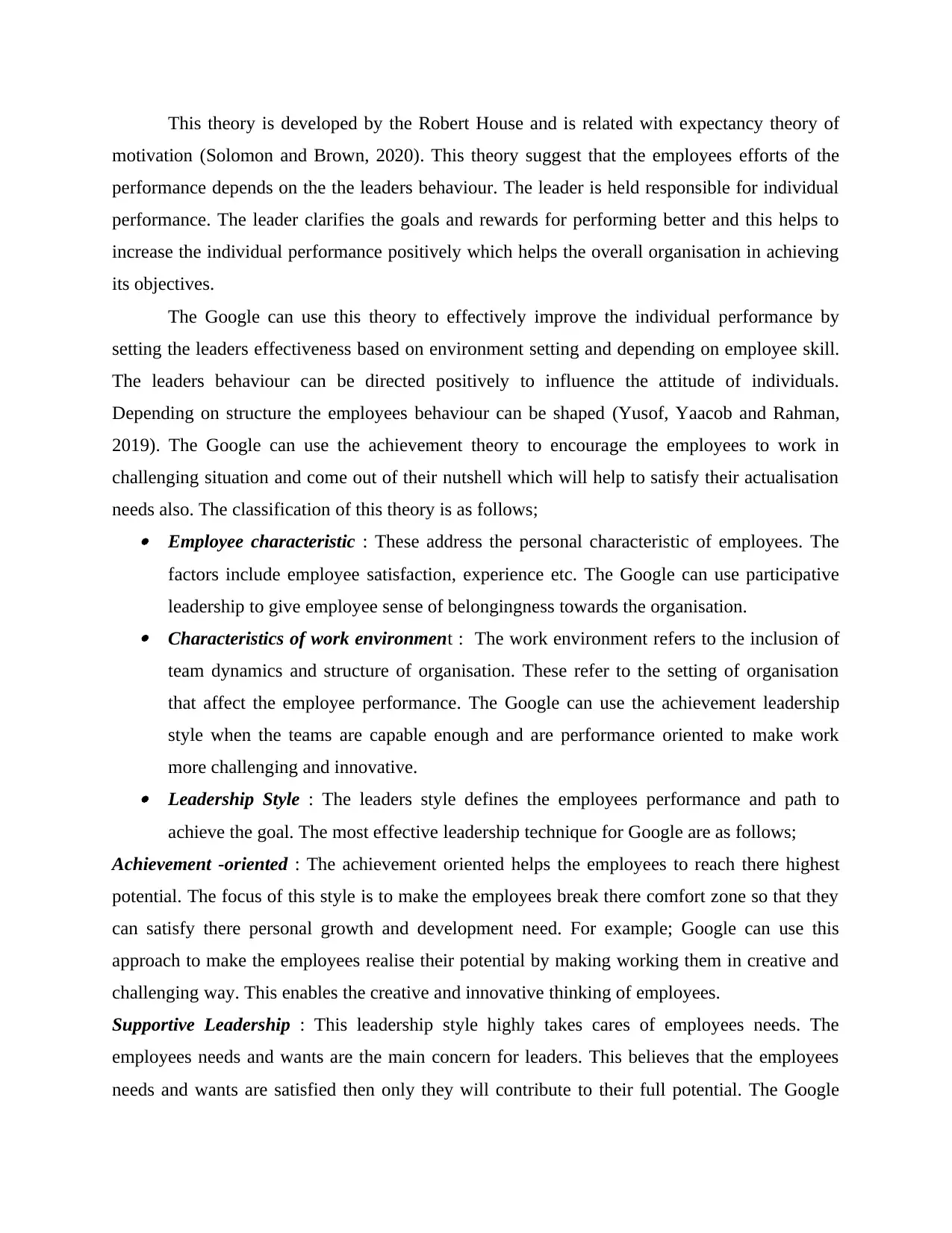
This theory is developed by the Robert House and is related with expectancy theory of
motivation (Solomon and Brown, 2020). This theory suggest that the employees efforts of the
performance depends on the the leaders behaviour. The leader is held responsible for individual
performance. The leader clarifies the goals and rewards for performing better and this helps to
increase the individual performance positively which helps the overall organisation in achieving
its objectives.
The Google can use this theory to effectively improve the individual performance by
setting the leaders effectiveness based on environment setting and depending on employee skill.
The leaders behaviour can be directed positively to influence the attitude of individuals.
Depending on structure the employees behaviour can be shaped (Yusof, Yaacob and Rahman,
2019). The Google can use the achievement theory to encourage the employees to work in
challenging situation and come out of their nutshell which will help to satisfy their actualisation
needs also. The classification of this theory is as follows; Employee characteristic : These address the personal characteristic of employees. The
factors include employee satisfaction, experience etc. The Google can use participative
leadership to give employee sense of belongingness towards the organisation. Characteristics of work environment : The work environment refers to the inclusion of
team dynamics and structure of organisation. These refer to the setting of organisation
that affect the employee performance. The Google can use the achievement leadership
style when the teams are capable enough and are performance oriented to make work
more challenging and innovative. Leadership Style : The leaders style defines the employees performance and path to
achieve the goal. The most effective leadership technique for Google are as follows;
Achievement -oriented : The achievement oriented helps the employees to reach there highest
potential. The focus of this style is to make the employees break there comfort zone so that they
can satisfy there personal growth and development need. For example; Google can use this
approach to make the employees realise their potential by making working them in creative and
challenging way. This enables the creative and innovative thinking of employees.
Supportive Leadership : This leadership style highly takes cares of employees needs. The
employees needs and wants are the main concern for leaders. This believes that the employees
needs and wants are satisfied then only they will contribute to their full potential. The Google
motivation (Solomon and Brown, 2020). This theory suggest that the employees efforts of the
performance depends on the the leaders behaviour. The leader is held responsible for individual
performance. The leader clarifies the goals and rewards for performing better and this helps to
increase the individual performance positively which helps the overall organisation in achieving
its objectives.
The Google can use this theory to effectively improve the individual performance by
setting the leaders effectiveness based on environment setting and depending on employee skill.
The leaders behaviour can be directed positively to influence the attitude of individuals.
Depending on structure the employees behaviour can be shaped (Yusof, Yaacob and Rahman,
2019). The Google can use the achievement theory to encourage the employees to work in
challenging situation and come out of their nutshell which will help to satisfy their actualisation
needs also. The classification of this theory is as follows; Employee characteristic : These address the personal characteristic of employees. The
factors include employee satisfaction, experience etc. The Google can use participative
leadership to give employee sense of belongingness towards the organisation. Characteristics of work environment : The work environment refers to the inclusion of
team dynamics and structure of organisation. These refer to the setting of organisation
that affect the employee performance. The Google can use the achievement leadership
style when the teams are capable enough and are performance oriented to make work
more challenging and innovative. Leadership Style : The leaders style defines the employees performance and path to
achieve the goal. The most effective leadership technique for Google are as follows;
Achievement -oriented : The achievement oriented helps the employees to reach there highest
potential. The focus of this style is to make the employees break there comfort zone so that they
can satisfy there personal growth and development need. For example; Google can use this
approach to make the employees realise their potential by making working them in creative and
challenging way. This enables the creative and innovative thinking of employees.
Supportive Leadership : This leadership style highly takes cares of employees needs. The
employees needs and wants are the main concern for leaders. This believes that the employees
needs and wants are satisfied then only they will contribute to their full potential. The Google
⊘ This is a preview!⊘
Do you want full access?
Subscribe today to unlock all pages.

Trusted by 1+ million students worldwide
1 out of 15
Related Documents
Your All-in-One AI-Powered Toolkit for Academic Success.
+13062052269
info@desklib.com
Available 24*7 on WhatsApp / Email
![[object Object]](/_next/static/media/star-bottom.7253800d.svg)
Unlock your academic potential
Copyright © 2020–2025 A2Z Services. All Rights Reserved. Developed and managed by ZUCOL.



